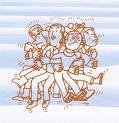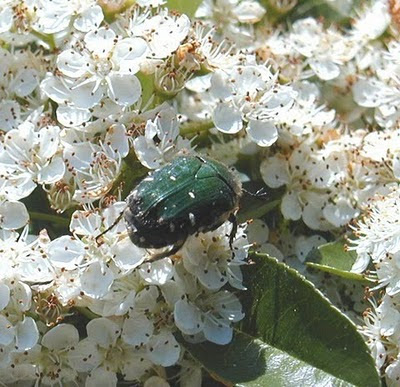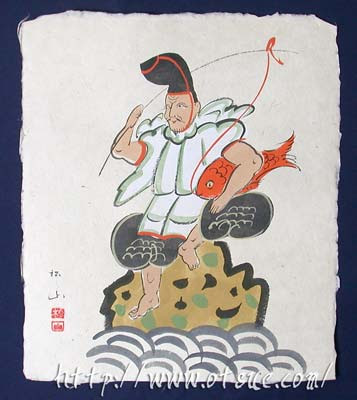[ . BACK to WORLDKIGO TOP . ]
::::::::::::::::::::::::::::::::::::::::::::::::::::::::::::::::::::::::::::::::::::::::::::::::::::
Basho in Kanegasaki, Tsuruga
Shrine Kehi Jingu 気比神宮 and Ironohama beach
The mystery background story
of the bell at the bottom of the sea
月いづく鐘は沈める海の底
(つきいずく かねはしずめる うみのそこ)
tsuki izuku kane wa shizumeru umi no soko
or
月いづこ鐘は沈める海の底」
tsuki izuko kane wa shizumeru umi no soko
there is also another version, quoted much less
月いづこ鐘は沈みて海の底
tsuki izuko kane wa shizumite umi no soko
written on the 15th day of the 8th (lunar) month, 1689
元禄2年8月15日
(Some translators place this haiku in September.)
This haiku is not included in the "Narrow Road".
.................................................................................
the following is a qoute from
source : www.roadrunnerjournal.net :
SURREALISM & CONTEMPORARY HAIKU
~ OR ~
SURREAL HAIKU?
by Philip Rowland
Other examples of somewhat surrealistic, classic haiku include Bashō’s:
where is the moon?
the temple bell is sunk
at the bottom of the sea
Shuson’s commentary on this haiku underlines its highly subjective and imaginative (even “fanciful”) power: “In his mind Bashō saw the light of the full moon and heard the faint sound of the bell. Although there was no moon in actuality, its absence led him to fly on wings of fancy to a mysterious but concrete world in his imagination.”
Shuson’s comment is a useful reminder that the “mysteriousness”of a perception need not detract from its vividly “concrete” poetic rendering.
Philip Rowland
.................................................................................
To know the full historical backgound of this haiku might take it out of the realm of "surreal" ?
I do not think it is surreal in the way for example
"blue sharks in the plum garden", also quoted by Rowland.
I read the haiku as a realistic report of the situation given that night.
So here is the full story below.
:::::::::::::::::::::::::::::::::::::::::::::::::::::::::::::::::::::::::::::::::::::::::::::::::::
Tsuki izuko kane wa shizumite umi no soko
Whither bound, the moon?
Sunken, lies the bell,
at the bottom of the sea.
Tr. Thomas McAuley
where's the moon?
the temple bell sunk
to the bottom of the sea
Tr. David Landis Barnhill
:::::::::::::::::::::::::::::::::::::::::::::::::::::::::::::::::::::::::::::::::::::::::::::::::::
Basho writes:
Tsuruga, Station 41
I entered the port of Tsuruga on the night of the fourteenth. The sky was clear and the moon was unusually bright. I said to the host of my inn, 'I hope it will be like this again tomorrow when the full moon rises.' He answered, however, 'The weather of these northern districts is so changeable that, even with my experience, it is impossible to foretell the sky of tomorrow.'
It rained on the night of the fifteenth,
just as the host of my inn had predicted.
source : www.uoregon.edu
It Tsuruga, on the night before the full moon, Basho visited the
Kehi shrine 気比神宮 , see below.
He spent the night viewing the moon, in memory of priest Ippen, the Holy Saint Yugyo 遊行上人 (Yugyoo Shoonin), a person of the Kamakura period which he admired very much.
:::::::::::::::::::::::::::::::::::::::::::::::::::::::::::::::::::::::::::::::::::::::::::::::::::
Basho stayed at Kanegasaki in Tsuruga 敦賀金ヶ崎, waiting for the full moon of the autumn on the night of the 15th.
 Konzenji 金前寺
Konzenji 金前寺
Guided by Tenya Goroemon 天屋五郎右衛門 he visited the temple Konzenji, where he wrote the above haiku in memory of the brave samurai who had died here.
Here is the story about the bell:
Bells of this kind were used to give signals to the soldiers far away.
 sample of a war bell
sample of a war bell
The castle Kanegasakijoo 金崎城 / 鐘ヶ崎城 is the place where
Nitta Yoshisada (1301 - 1338) fought against Ashikaga Takauji 足利尊氏 (1305 - 1358), who was trying to topple the government.
On the sixth day of the third month in 1337 (lunar calendar) the army of Nitta had no more chance to win, so Nitta Yoshiaki ( ? - 1337), oldest son of Yoshisada, his friend Takanaga Shinnoo 尊良親王 (1311 - 1337), second son of emperor Godaigo Tenno and some others committed ritual suicide at the beach.
During this suicide, the bronze war bell (軍鐘) of Yoshisada was burried with them in the sand too.
Later people tried to recover the bell, but the bell had turned upside down, filled with sand and sunk to the deep bottom of the sea, beyond recovery.
Yoshisada died in the same year, on the second day of the seventh month, during a fight in Fukui Town at the temple Tomyo-ji (Toomyooji) 燈明寺.
where is the full moon?
the war bell has sunk
to the bottom of the sea
Tr. Gabi Greve

金前寺 芭蕉句碑
Basho Haiku Memorial Stone at Temple Konzenji
source : okuno_h

Kanegasaki guu 金ヶ崎宮 / 金崎宮 -かねがさきぐう-
Shrine at Kanegasaki
Now a place to bring lovers together.
http://kanegasakigu.jp/
.................................................................................
Two important figures in ancient Japan
Referecne : Ashikaga Takauji
Referecne : Nitta Yoshisada
:::::::::::::::::::::::::::::::::::::::::::::::::::::::::::::::::::::::::::::::::::::::::::::::::::::
David Coomler has this (and more):
Old hokku sometimes included historical, literary, or cultural allusions that make them very difficult for modern English-language readers to understand. As I have already explained, we say that such verses “Do not travel well.” That means they require so much explanation even after translation that any strength that might have been in the hokku is largely lost.
And of course many such allusive hokku were not very good to begin with. Nonetheless, when the average Westerner reads them, completely unfamiliar with the background to such verses, the likelihood of misunderstanding becomes very high.
Where is the moon?
The bell has sunk
To the bottom of the sea.
snip
Actually, however, Bashō is not being surreal or exhibiting a wild imagination; he is referring to an historical event, one of many that took place during the gruesome and violent political history of Japan. Without going into detail, there was a military defeat and suicides at a beach, and a large bell associated with the event sank into the sea. From that alone we can see that what we find in the verse is not surrealism — just historical allusion.
snip
The average Western reader, however, ignorant of the allusion and of the technique alike, will likely end up with some confused notion of what the verse is all about — perhaps even describing it (quite inaccurately) somewhat as the fellow mentioned earlier did — as imaginative and surreal.
THERE’S A BELL AT THE BOTTOM OF THE SEA
::::::::::::::::::::::::::::::::::::::::::::::::::::::::::::::::::::::::::::::::::::::::::::::::::::
Reference
Ueda : Bashō and his interpreters
google book
Japanese reference : 月いづく鐘は沈める海の底
:::::::::::::::::::::::::::::::::::::::::::::::::::::::::::::::::::::::::::::::::::::::::::::::::::::
The stone stairs up to the shrine Shrine at Kanegasaki are 92 in number,
KU NI, meaning "to have no worries" and you have to run them up to get rid of your worries.
. Flower-exchanging festival
花換祭 / 花換祭り hanakae matsuri
kigo for late spring
:::::::::::::::::::::::::::::::::::::::::::::::::::::::::::::::::::::::::::::::::::::::::::::::::::::
:::::::::::::::::::::::::::::::::::::::::::::::::::::::::::::::::::::::::::::::::::::::::::::::::::::
Some thoughts on my translation
Can one word make a difference ? I hope so.
kane 鐘
This word has been translated in three ways for the haiku of Basho
bell, temple bell and war bell
In Japanese,
kane is not just any bell, like a door bell or church bell,
but a very special one.
The
temple bell would imply some sort of peace (as a haiku friend has pointed out).
The
war bell tries to imply just the oposite.
Since we know from the background of this haiku, Basho is not refering to a temple bell, but one that belongs to a warlord to summon his troups.
For want of better English, I choose
war bell (Kriegsglocke), but it may also be "army bell" or something else.
Please help with the English.
I also think it is important to show that the poem refers to a story of the past, hence using HAS SUNK.
. Riddles and Haiku The Real, the Surreal, the Metaphysical
Comment from a haiku friend :
I'm glad to know the background to this haiku ... it adds to it for me.
But I do find myself wondering why, even without knowing the facts, anyone would have found it surreal.
I can't find anything surreal in it at all.
.................................................................................
ou est la lune?
la cloche de guerre a sombre
au fond de la mer
Tr. Daniel Py
::::::::::::::::::::::::::::::::::::::::::::::::::::::::::::::::::::::::::::::::::::::::::::::::::::
Basho wrote five haiku during his stay in Tsuruga
名月や北国日和定なき - meigetsu ya Hokkoku-biyori sadamenaki
This is the one featured in "Oku no Hosomichi".
月いづく鐘は沈める海の底 - tsuki izuku
This is the one we are discussing here.
古き名の角鹿や恋し秋の月
. furuki na no Tsunuga ya koishi aki no tsuki .
- - - - -
月清し遊行のもてる砂の上
tsuki kiyoshi Yugyoo no moteru suna no ue
1689, gazing at the moon in Tsuruga Bay, I visited
Kei Shrine
and heard of the tradition of the Yugyo Abbots:
the moon so pure
on the sand carried here
by the Pilgrim Priests
Tr. Barnhill
Shining on sand
transported by pilgrims -
pure light of the moon.
Tr. Helen Craig McCullough
The sand is so white it looks almost like snow. The saint 遊行二世 Second Yugyo came here to fulfill his great prayer vow. He cleared the marshy access road of weeds, carried sand, pebbles, stones and sandbags (deitei 泥渟 ?deinei) to make a walk for the pilgrims.
This is now called
Yugoo no sunamochi 遊行の砂持 "Yugyo pilgrims carrying sand" and was later done by the other priests here. People now have to leave the shoes at the beginning of the walk.
The second Yugyo was Saint
Ta-A Shonin 他阿上人,
Ta Amidabutsu Shoonin 他阿弥陀仏上人, (1237 - 1319) Saint Ta-A.
二祖遊行上人 of the Jishu 時宗 sect of Pure Land Buddhism 浄土宗
Since 1277 he followed in the steps of Ippen, from Kyushu. After the death of Ippen he walked along Japan, mainly in Hokuriku and Kanto.
In 1304 he passed the title to the Third Yugyo 他阿智得 and became head priest of the temple Muryookoo Ji 無量光寺 Muryoko-Ji in Sagamihara, now Kanagawa prefecture, the main temple of the Jishu sect.
© More in the Japanese WIKIPEDIA !
. the First Yugyoo 遊行 priest Saint Ippen 一遍 .
(1239 - 1289)
The term Yugyoo 遊行 Yugyo denotes being itinerant and wayfaring for missionary work.
Today's Yugyo Shonin (73th) holds the post of Fujisawa Shonin (55th) concurrently.
. Matsuo Basho visiting Shinto Shrines .
 © PHOTO : tsuruga/kehijingu1.html
Statue of Basho at shrine Kehi Jingu
国々の八景更に気比の月
© PHOTO : tsuruga/kehijingu1.html
Statue of Basho at shrine Kehi Jingu
国々の八景更に気比の月
kuniguni no hakkei sara ni Kehi no tsuki
many regions
have many famous places -
and then the moon of Kehi
(
hakkei refers to "eight scenic spots", according to ancient Chinese tradition.)
. Famous HAKKEI 八景 Eight Views of Japan .
. . . CLICK here for Photos of Kehi Shrine 気比神宮 .
 Kehi Jinguu 気比神宮 Shrine Kehi Jingu
Kei Shrine
Kehi Jinguu 気比神宮 Shrine Kehi Jingu
Kei Shrine according to Barnhill
quote
Kehi Shrine has a long and distinguished history. Located in the port town of Tsuruga, it is believed to have been founded in 702. It has been gathering place for worship as the head of tutelary of Hokuriku Road.
It enshrines the seven deities:
Isasawake-no-Mikoto, Emperor Chuai, Empress Jingu-Kogo, Emperor Ohjin, Takenouchi-no-Sukune-no-Mikoto, Yamato-Takeru-no-Mikoto, and Tamahime-no-Mikoto;
and each god is believed to bring good fortune to the performing arts, provide good hauls and harvests, a perfect state of health and longevity, etc. The water springing from shrine premises since the time of its establishment is also admired by local people as giving long life.
The shrine gate painted in red with the height of 11m were built in 1645 and are designated as a national important cultural asset. It is counted as one of the three grate shrine gates of Japan along with Kasuga Taisha Shrine (in Nara Prefecture) and Itsukushima Shrine (in Hiroshima Prefecture).
The Tsuruga Festival held in the beginning of September is referred to as the greatest festival in Hokuriku region, attracting a lot of people from both inside and outside the prefecture to see the heroic scene of Mikoshi (portable shrines) and Dashi (festival floats) parading inside the city.
Kehi-no-Matsubara Pine Grove 気比ノ松原 , stretching along the Tsuruga Bay on the west side of the Kehi Shrine, is regarded as one of the three fine pine groves in Japan along with the Miho-no-Matsubara (Shizuoka Prefecture) and Niji-no-Matsubara (Saga Prefecture). About 17,000 Japanese red pine and black pine trees stand all along the white sand beach with a walking trail. In summertime many people visit this beach to enjoy swimming.
source : www.japan-i.jp/explorejapan
Deities in residence
笥飯大神、御食津大神とも称し、二千有余年、天筒の嶺
Homepage of the shrine
source : kehijingu.jp
sacred messenger animal is the white egret
sagi 鷺
snow heron, white egret
. shinshi 神使 the divine messenger .
. WKD : Heron (aosagi) Egret (shirasagi) .
There is also a special statue of
. 桃太郎神 Momotaro the Peach Boy as Deity .
.................................................................................

Photo album from Taisaku Nogi san:
Kehi Shrine
source : facebook
Photos from the float parade
Festival Tsuruga Matsuri 敦賀祭り
source : www.yuugao.jp
::::::::::::::::::::::::::::::::::::::::::::::::::::::::::::::::::::::::::::::::::::::::::::::::::::
observance kigo for mid-autumn
Kehi matsuri 気比祭 (けひまつり) Kehi festival
Tsuruga matsuri 敦賀祭(つるがまつり)Tsuruga festival
from September 2 to 15.
On September 3 is a mikoshi parade.
September 4 is the main event with huge floats parading through town.
 quote
Tsuruga Matsuri Festival
quote
Tsuruga Matsuri Festival
This festival is part of a longer festival (lasting from September 2nd to September 15th) and is the annual autumn ceremony at Kehi Shrine.
The first 3 days of this long festival are called
Tsuruga Matsuri. It starts on the eve of the festival with a traditional Chigo dance. Then big parades begin with 6 portable ‘Goshintai’a symbol of the spirit of a deity)shrine floats which date from the Muromachi period. They are followed by great carnival marching and Minyo dances. This festival excites people visiting Tsuruga during this festival.
source : www.fuku-e.com
:::::::::::::::::::::::::::::::::::::::::::::::::::::::::::::::::::::::::::::::::::::::::::::::::::::
On his last day in Tsuruga, Basho visited the
"Colorful Beach", Ironohama
色浜 (いろのはま)
 波の間や小貝にまじる萩の塵
波の間や小貝にまじる萩の塵
nami no ma ya kogai ni majiru hagi no chiri
between the waves -
small shells are mixed with
scattered bush-clover petals
The small pretty shells of this beach, Masuho no kogai, are quite famous.
. bushclover (hagi) and haiku
Another hokku about the Masuho shells of Ironohama :
ko hagi chire Masuho no ko-gai ko sakazuki
. Matsuo Basho 松尾芭蕉 - Archives of the WKD .
The weather was fine again and he took a boat to the shrine Jogu Jinja (常宮神社 Jooguu Jinja), which is closely related to Kehi Jingu.
寂しさや須磨にかちたる浜の秋
sabishisa ya Suma ni kachitaru hama no aki
. WKD : Basho, Suma and Iro no Hama
須磨 と 色の浜
須磨の浦の年取り物や柴一把
Suma no Ura no toshitori mono ya sai ichiha
passing into the New Year
at Suma no Ura -
a bundle of brushwood
Reference
*****************************
Related words
*****
- - - Oku no Hosomichi 奥の細道 - - -
Station 41 -
Tsuruga 敦賀
*****
. Matsuo Basho 松尾芭蕉 - Archives of the WKD .
*****
. tsurigane 釣鐘 hanging bell and HAIKU
:::::::::::::::::::::::::::::::::::::::::::::::::::::::::::::::::::::::::::::::::::::::::::::::::::::
[ . BACK to DARUMA MUSEUM TOP . ]
[ . BACK to WORLDKIGO . TOP . ]
:::::::::::::::::::::::::::::::::::::::::::::::::::::::::::::::::::::::::::::::::::::::::::::::::::::















































